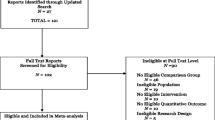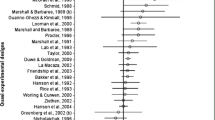Abstract
Published and unpublished data from nine studies on juvenile sexual offender treatment effectiveness were summarized by meta-analysis (N=2986, 2604 known male). Recidivism rates for sexual, non-sexual violent, non-sexual non-violent crimes, and unspecified non-sexual were as follows: 12.53%, 24.73%, 28.51%, and 20.40%, respectively, based on an average 59-month follow-up period. Four included studies contained a control group (n=2288) and five studies included a comparison treatment group (n=698). An average weighted effect size of 0.43 (CI=0.33–0.55) was obtained, indicating a statistically significant effect of treatment on sexual recidivism. However, individual study characteristics (e.g., handling of dropouts and non-equivalent follow-up periods between treatment groups) suggest that results should be interpreted with caution. A comparison of odds ratios by quality of study design indicated that higher quality designs yielded better effect sizes, though the difference between groups was not significant.
Similar content being viewed by others
Notes
Although the Walker et al. (2004) study included unpublished data for some treatment outcomes, it did not include unpublished data using recidivism as an outcome.
Information regarding gender and age were unavailable in one study, gender information was incomplete in another study, and information about race was unavailable in two studies.
References
References marked with an asterisk indicate studies included in the meta-analysis.
Alexander, M. A. (1999). Sexual offender treatment efficacy revisited. Sexual Abuse: A Journal of Research and Treatment, 11, 101–116.
Andrews, D. A., & Bonta, J. (2002). The psychology of criminal conduct. Cincinnati, OH: Anderson Publishing Co.
Andrews, D. A., & Dowden, C. (2006). Risk principle of case classification in correctional treatment: A meta-analytic investigation. International Journal of Offender Therapy and Comparative Criminology, 50, 88–100.
Becker, J. V., & Hicks, S. J. (2003). Juvenile sexual offenders: Characteristics, interventions, and policy issues. Annals of the New York Academy of Sciences, 989, 387–410.
Beech, A. R., Robertson, C., & Freemantle, N. (2005). The influence of study design when evaluating psychological treatment for sex offenders: A meta-analysis. poster presented at the 24th annual research and treatment conference of the association for the treatment of sexual abusers. Salt Lake City, Utah.
Begg, C. B. (1994). Publication bias. In H. Cooper & L. V. Hedges (Eds.), The handbook of research synthesis (pp. 399–409). New York: Russell Sage Foundation.
*Borduin, C. M., Henggler, S. W., Blaske, D. M., & Stein, R. J. (1990). Multisystemic treatment of adolescent sexual offenders. International Journal of Offender Therapy and Comparative Criminology, 34, 105–113.
*Borduin, C. M., & Schaeffer, C. M. (2001). Multisystemic treatment of juvenile sexual offenders: A progress report. Journal of Psychology and Human Sexuality, 13, 25–42.
Burton, D. L. & Smith-Darden, J. (2000). 1996 nationwide survey: A summary of the past ten years of specialized treatment with projections for the coming decade. Brandon, VT: Safer Society Program & Press.
Burton, D. L. & Smith-Darden, J. (2001). North American survey of sexual abuser treatment and models summary data. Brandon, VT: Safer Society Program & Press.
*Cooper, H. M., & Schmidt, F. (2000). Long-term follow-up of a community-based treatment program for adolescent sex offenders. Unpublished manuscript.
Fleiss, J. L. (1994). Measures of effect size for categorical data. In H. Cooper & L. V. Hedges (Eds.), The handbook of research synthesis (pp. 245–260). New York: Russell Sage Foundation.
Frick, P. J. (1998). Conduct disorders and severe antisocial behavior. New York, NY: Plenum Press.
Gallagher, C. A., Wilson, D. B., Hirschfield, P., Coggeshall, M. B., & MacKenzie, D. L. (1999). A quantitative review of the effects of sex offender treatment on sexual reoffending. Corrections Management Quarterly, 3, 19–29.
Groth, N. A., Longo, R. E., & McFaddin, J. B. (1982). Undetected recidivism among rapists and child molesters. Crime and Delinquency, 128, 450–458.
Hall, G. C. N. (1995). Sexual offender recidivism revisited: A meta-analysis of recent treatment studies. Journal of Consulting and Clinical Psychology, 63, 802–809.
Hanson, R. K., Broom, I., & Stephenson, M. (2004). Evaluating community sex offender treatment programs: A 12-year follow-up of 724 offenders. Canadian Journal of Behavioral Science, 36, 87–96.
Hanson, R. K., & Bussiere, M. T. (1998). Predicting relapse: A meta-analysis of sexual offender recidivism studies. Journal of Consulting and Clinical Psychology, 66, 348–362.
Hanson, R. K., Gordon, A., Harris, A. J., Marques, J. K., Murphy, W., Quinsey, V. L., & Seto, M. C. (2002). First report of the collaborative outcome data project on the effectiveness of psychological treatment for sexual offenders. Sexual Abuse: A Journal of Research and Treatment, 14, 169–194.
Hunter, J. A. (1999). Understanding juvenile sexual offending behavior: Emerging research, treatment approaches, and management practices. Silver Spring, MD: Center for Sex Offender Management. Retrieved November 3, 2002, from http://www.csom.org/pubs/juvbrf10.html
*Hurley, S. (2002). Unpublished raw data.
*Jeffords, C. (2003). Unpublished raw data.
*Lab, S. P., Shields, G., & Schondel, C. (1993). Research note: An evaluation of juvenile sexual offender treatment. Crime & Delinquency, 39, 543–553.
Lambie, I., Hickling, L., Seymour, F., Simmonds, L., Robson, M., & Houlahan, C. (2000). Using wilderness therapy in treatment adolescent sexual offenders. The Journal of Sexual Aggression, 5, 99–117.
Letourneau, E. J. (2004). Letter to the editor: A comment on the first report. Sexual Abuse: A Journal of Research and Treatment, 16, 77–81.
Mailloux, D. L., Abracen, J., Serin, R., Cousineau, C., Malcolm, B., & Looman, J. (2003). Dosage of treatment to sexual offenders: Are we overprescribing? International Journal of Offender Therapy and Comparative Criminology, 47, 171–184.
Marshall, W. L., Fernandez, Y. L., Hudson, S. M., & Ward, T. (Eds.). (1998). Sourcebook of treatment programs for sexual offenders. New York: Plenum Press.
*McTavish, T. H. (1996). Performance audit of the W. J. Maxey Training School. Unpublished report.
Miller, W. R., & Rollnick, S. (Eds.). (2002). Motivational interviewing: Preparing people for change, 2nd edn. New York: The Guilford Press.
National Task Force on Juvenile Sexual Offending (1988). Preliminary report. Juvenile and Family Court Journal, 39, 1–67.
Orwen, R. G. (1994). Evaluating coding decisions. In H. Cooper & L. V. Hedges (Eds.), The handbook of research synthesis (pp. 139–162). New York: Russell Sage Foundation.
Prentky, R., Harris, B., Frizzell, K., & Righthand, S. (2000). An actuarial procedure for assessing risk with juvenile offenders. Sexual Abuse: A Journal of Research and Treatment, 12, 71–93.
Rice, M. E., & Harris, G. T. (2003). The size and sign of treatment effects in sex offender therapy. Annals of the New York Academy of Sciences, 989, 428–440.
Rosenthal, M. C. (1994). The fugitive literature. In H. Cooper & L. V. Hedges (Eds.), The handbook of research synthesis (pp. 86–94). New York: Russell Sage Foundation.
Shadish, W. R., & Haddock, C. K. (1994). Combining estimates of effect size. In H. Cooper & L. V. Hedges (Eds.), The handbook of research synthesis (pp. 261–281). New York: Russell Sage Foundation.
Sickmund, M., & Wan, Y. (2001). Census of juveniles in residential placement databook. Washington, DC: U. S. Department of justice, office of juvenile justice and delinquency prevention. Retrieved on November 2, 2002, from http://www.ojjdp.ncjrs.org/ojstatbb/cjrp
Snyder H. (2002). Juvenile Arrests 2000 [forthcoming]. Washington, DC: Office of Juvenile justice and delinquency prevention. Retrieved on November 2, 2002, from http://ojjdp.ncjrs.org/ojstatbb/html/qa250.html.
Snyder, H., Poole, R., & Kang, W. (2001). Easy access to FBI arrest statistics 1994–1998. Washington, DC: Office of Juvenile Justice and Delinquency Prevention. Retrieved on November 2, 2002, from http://ojjdp.ncjrs.org/ojstatbb/ezaucr/
Snyder, H. N., & Sickmund, M. (1999). Juvenile offenders and victims: 1999 national report. (Report No. NCJ-178257). Washington, DC: U. S. Department of justice, office of juvenile justice and delinquency prevention. Retrieved on November 2, 2002, from http://www.ojjdp.ncjrs.org/ojstatbb/index.html
Stahl, A. (2000). Delinquency cases in juvenile courts, 1997. (Fact Sheet No. 200004). Washington, D. C.: U. S. Department of justice, office of juvenile justice and delinquency prevention.
Trivits, L. C., & Repucci, N. D. (2002). Application of Megan’s Law to juveniles. American Psychologist, 57, 690–704.
Veneziano, C. & Veneziano, L. (2002). Adolescent sex offenders: A review of the literature. Trauma, Violence, & Abuse: A Review Journal, 3, 247–260.
Walker, D. F., McGovern, S. K., Poey, E. L., & Otis, K. E. (2004). Treatment effectiveness for male adolescent sexual offenders: A meta-analysis and review. Journal of Child Sexual Abuse, 13, 281–293.
White, H. D. (1994). Scientific communication and literature retrieval. In H. Cooper & L. V. Hedges (Eds.), The handbook of research synthesis (pp. 42–55). New York: Russell Sage Foundation.
*Wieckowski, E., Waite, D., Pinkerton, R., McGarvey, E., & Brown, G. L. (2003). Sex offender treatment in a juvenile correctional setting: Program description and nine-year outcome study. Unpublished presentation.
*Worling, J. R., & Curwen, T. (2000). Adolescent sexual offender recidivism: success of specialized treatment and implications for risk prediction. Child Abuse & Neglect, 24, 965–982.
Worling J. R., & Långström N. (2006). Risk of sexual recidivism in adolescents who offend sexually: Correlates and assessment. In H. E. Barbaree & W. L. Marshall (Eds.), The Juvenile Sex Offender, 2nd edn. (pp. 219–247). New York: Guilford press.
Acknowledgements
We would like to thank undergraduate research assistants, Michael Cowley and Christina Holley, for their respective contributions to this project, and express our sincere appreciation to those individuals who were instrumental in allowing us access to their unpublished data sets, without which this study could not have been conducted.
Author information
Authors and Affiliations
Corresponding author
Additional information
This paper is based on a dissertation written for the completion of a Doctor of Philosophy degree in clinical psychology at Florida State University. The dissertation was awarded the Association for the Treatment of Sexual Abusers’ (ATSA) Graduate Research Award in 2005, with results presented at the 2005 ATSA con- ference in Salt Lake City, Utah. Lorraine R. Reitzel is currently a postdoctoral fellow at the University of Texas, M. D. Anderson Cancer Center in Houston, Texas.
Rights and permissions
About this article
Cite this article
Reitzel, L.R., Carbonell, J.L. The Effectiveness of Sexual Offender Treatment for Juveniles as Measured by Recidivism: A Meta-analysis. Sex Abuse 18, 401–421 (2006). https://doi.org/10.1007/s11194-006-9031-2
Published:
Issue Date:
DOI: https://doi.org/10.1007/s11194-006-9031-2




